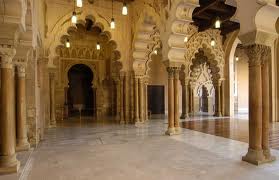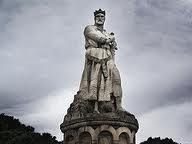
Zaragoza, like most other Spanish cities, has certainly seen its fair share of civilizations, conquests, re-conquests and brutal bloody wars. People here are famous for being a stubborn, proud and noble people, and rightfully so. With one look at their history, it is easy to see why they hold on so strongly to what their ancesters once fought so valiantly to preserve. And so, Zaragoza, and Aragon's history seems to stand out among the rest, in the way that this area's legacy has not only affected its own people, but has also had a significant influence that, at one time, stretched not only all through Spain but even as far as Greece, Italy and the Americas.
Zaragoza started out in the 5th century B.C. as an Iberian Settlement on the Banks of the River Ebro. Than, in 14 B.C. that all changed as the Romans came to town and claimed this strategic colony as their own. It was named Caesaraugustus, and was an outpost set up as a defence against the advancing Visigoth Kingdoms. But, it wasn't long before it became one of the largest cities in the province of Tarraco, with an estimated population of 30, 000 people at its peak. It's importance only continued to grow as it became a central spot for the expansion of Roman culture, which would eventually lead to a latinisation that would sweep through a huge percentage of the Iberian Peninsula.

The glory days of the Roman Empire, however, were drawing to an end and it was another infamous group of conquerors, who were making their way methodically through the land, that would take this prize for themselves, the Muslims. They arrived in 714 , conquered the city and renamed it Saraqusta. Like it was for the Romans, this city became a logistical base for them, acting as a starting point for Muslim invasions around the Ebro Valley and into France.
As the city developed and expanded, it prospered and became known as an open, cultural and artistic haven, offering a kind of sanctuary to intellectuals of all backgrounds and religions. In a rare moment in history Muslims, Jews, and Christians all lived side by side here, coexisting and making Saraqusta into one of the most important Taifas in the peninsula. Evidence of this grandeur can be seen in the magnificent Aljaferia Palace, built as a home for the Sultan King Abu Jafar Moctadir in 1045.
It was this very palace that would become the home of the next person to rule this city; Alfonso I. Known as "the Battler" this Christian King marched into town in 1118 and put an end to 4 centuries of Muslim rule. He made the magnificent Aljaferia his home, renamed the city Zaragoza/Saragossa, and made it the capital of of the newly formed Kingdom of Aragon.

In 1412 then King of Aragon, Ferdinand II married Isabella of Castile and set into motion a sequence of events that would eventually lead to the formation and unity of Spain as we know it today. This famous couple would also be the ones who finally agreed to fund legendary explorer Christopher Columbus, leading to the discovery of The Americas, and helping to spread the reign of the ever expanding kingdom of Aragon. These two also oversaw the "reconquista" from the Muslims in the south, the expulsion of Zaragoza's Jews and the orders of the infamous Spanish Inquisition. In fact, it was in the Aljaferia where the inquisitors held their courts from 1706 and onwards.
Ferdinand's death was followed by the rule of the House of Austria, and a line of kings beginning with Carlos I. The city expanded greatly in the 16th and 17th centuries and built itself up as an economic center. In the 18th century the Bourbon Monarchy began its reign with Philip V as its head. Then, in 1808 and 1809 the city fell under siege by Napolean's French Army. Several bloody battles destroyed much of the city. But, with the help of the famous General Palafox, they were able to hold off their would be occupiers.
From 1936 to 1939, during the Spanish Civil war, Zaragoza endured the Battle of the Ebro. Witnessing brutal fighting between Fascists in the centre and anarchists who were in control of the countryside. It was after the death of Franco, and during the transition to democracy, that Aragon, with Zaragoza as its capital, would become an Autonomous Community.